With the prowess and stealth of a jungle cat, BLACK PANTHER pounces into the Marvel canon with exhilarating, action-packed, edge of your seat excitement and entertainment! The film on the whole gives you a real bang for your buck at the box office and should set new box office records over the opening weekend. To describe the efforts of co-writer/director Ryan Coogler and company as bold and daring is an understatement!

A cherished, albeit less famous, character of the Marvel Universe, BLACK PANTHER first appeared in July 1966 with the Fantastic Four during what aficionados know as the “Silver Age of Comic Books.” Film audiences first got a glimpse of T’Challa aka BLACK PANTHER and the country of Wakanda in “Captain America: Civil War”. That first glimpse of not only T’Challa but the technologically superior Wakanda was astounding, but it gave rise to discussion about the BLACK PANTHER feature film and particularly, Ryan Coogler as co-writer and director. Given Coogler’s background of telling small, intimate stories, the anticipation of what he could and would do with BLACK PANTHER story-wise and then bring it to life visually on the big screen has reached a fever pitch in the final weeks leading up to the film’s release.
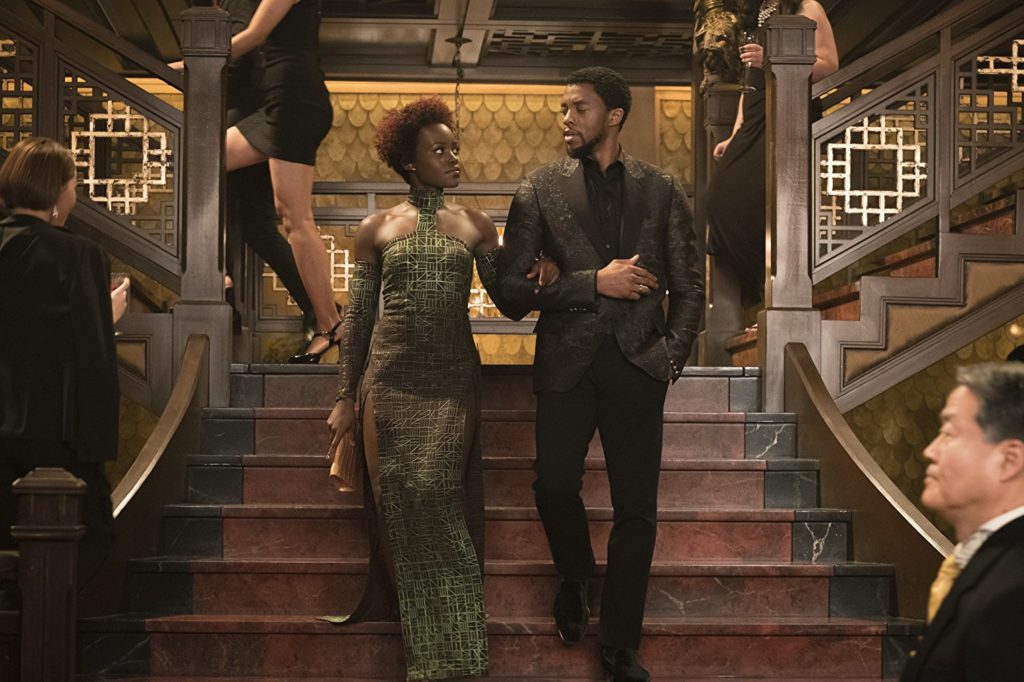
Although deviating somewhat from BLACK PANTHER’s comic book history, Coogler, along with co-writer Joe Robert Cole, plays to his strengths and does extremely well in establishing backstory thanks to setting the film predominantly in Wakanda, as well as crafting intimate moments and personal connections between the audience and the characters, much as he did in films like “Creed” and “Fruitvale Station”. We meet T’Challa post “Civil War” at home, assuming the role of King following the death of his father. There is great peace and ease between T’Challa and his step-mother Ramonda while a loving and sarcasm fueled sibling rivalry with his sister Shuri is a pure delight. The edginess of T’Challa’s relationship with former girlfriend Nakia not only builds ideals of friendship and loyalty, but provides plenty of humbling, and humorous, moments for T’Challa, with Nakia always getting the last word. And then there’s T’Challa’s military. All female and led by the most kick-ass, no-nonsense woman to ever appear on screen, Okoye, these women command the screen and set the action bar. We learn of the structure of Wakanda and its tribes as well as its customs, not to mention the secrets of vibranium. But while there is this great peace among Wakanda (even with one tribe who elected to not accept use of vibranium and lives high in the mountains), darkness looms, initially thanks to the evil Ulysses Klaue, and then in the form of challenger to the Wakandan throne, Erik Killmonger.
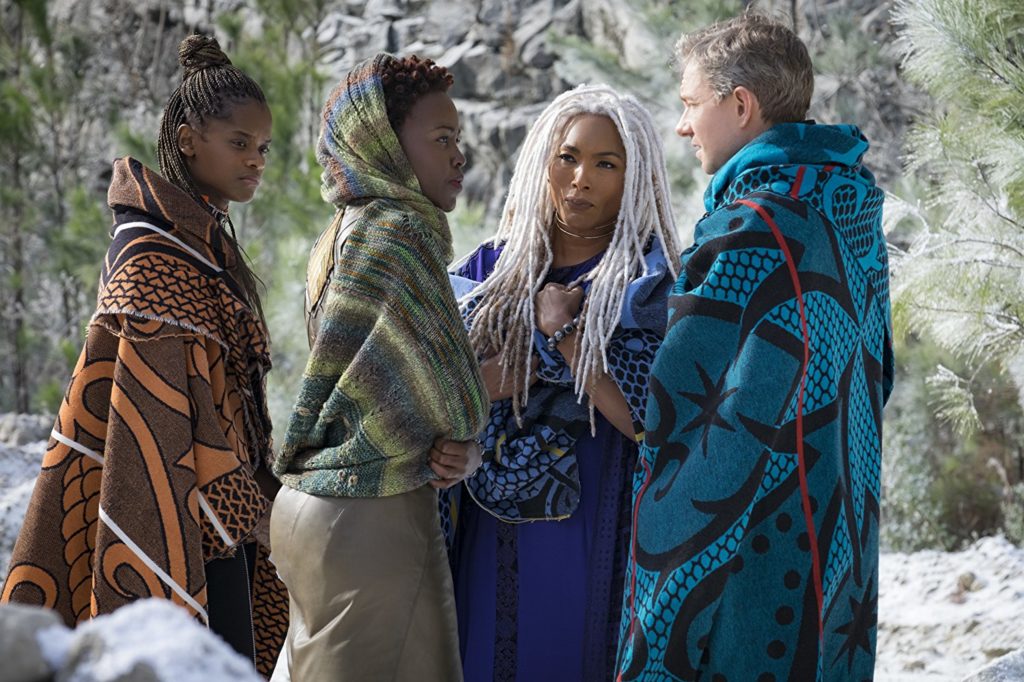
Having said that, Coogler may have bitten off more than he could chew. There are so many interesting characters in BLACK PANTHER, but not enough time to devote to and develop each one. And it’s the desire to want to know more about each and every one of these characters that speaks to Coogler’s skill with character construction, but in this case it is also beyond frustrating because of the time restrictions of a movie and the inability to fully develop all. For example, one look at a Wakandan tribe dressed in Frank Gorshin “Riddler” neon green suits with wood plates in their lips and ears is so standout it makes one crave knowing more about these mysterious people. Yes, the film is about T’Challa and coming into his own as King, but with the wealth and depth of characters which comprise his universe and the vibrancy of each captured with beautiful rich lensing visually drawing them inside the periphery begs for more exposition and expansion.

The foundation of the story in BLACK PANTHER is solidly grounded in the ideals of finding oneself, the collective voice of a people wanting to be heard, shedding the ghosts of the past and expectations, finding your own path, with great focus on the ambiguity of black & white/right & wrong. But that grounding goes off the rails with Michael B. Jordan as Killmonger. There are so many themes running through BLACK PANTHER that it gets dizzying: father-son, brother-sister, brother-brother, hate, warmongering, global issues, and the political differences resulting therein, strength by war over words, revenge and defiance. While T’Challa may talk about peace and harmony, the rest of the film is anything but.

Killmonger’s dialogue and the very presence that Michael B. Jordan imbues within the character is more than reminiscent of the radical militant end of the spectrum of the Black Power movement of the 60’s and 70’s which caused divisiveness and extreme violence throughout the United States during the Civil Rights Movement. And while there were varying extremes of the movement to instill racial pride and give a voice to the disenfranchised and then dismissed Black population, it was the far-reaching violence and leather-gloved fists thrust in the air that we now see as history brought to the forefront in BLACK PANTHER through the character of Killmonger and Jordan’s indelible performance. The language on screen is so inflammatory and such a “rallying cry” in the second act that when viewed within the spectrum of today’s world, it is powerful enough and vitriolic enough to incite a race war. This then begs the question, how far will the audience go with the themes that they see unfold on the screen? Will it spill over into the real world? How will Michael B. Jordan’s performance translate from screen to real life? And yes, it is undisputed that Jordan’s Killmonger is without a doubt one of the most morally vile and reprehensible of not only all the Marvel villains to date, but villains period, perpetuated by a thirst for militant martyrdom.
In short, there is just so much thematically, that it is actually too much. Coogler would have done better to break down some of the themes into outlines and treatments for second and third BLACK PANTHER films.
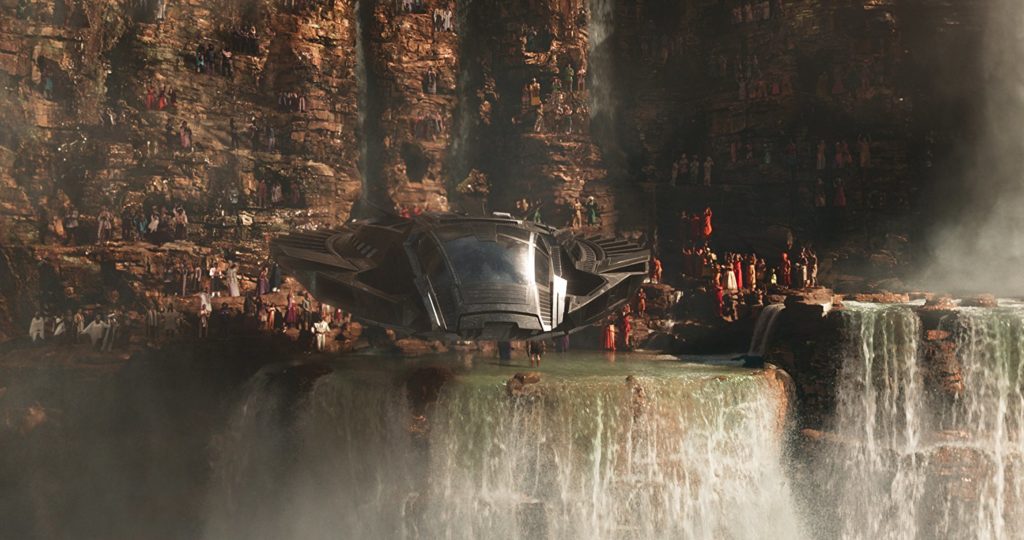
Technically, the film is superb. BLACK PANTHER is a film which visually rises and falls on production design, costume design and cinematography and dare it be said now, but “Calling Oscar 2019 for Hannah Beachler and Ruth Carter!!”
Hannah Beachler’s production design is off the charts incredible as is the costume design of Ruth Carter. If we don’t believe in the world of Wakanda which is idyllic in its blend of new and old worlds, then the film doesn’t work at all. Thanks to Beachler, from the high tech of Shuri’s lab and technology to the delicacy and sentimentality of Nakia’s room where Agent Ross (he’s back!) is recovering to a small apartment in 1992 Oakland to a casino in Korea, the world is visceral and real, creating an almost tactile – and eye-popping – viewing experience. The meld of traditional African culture, history, and geography creates a rich, lush palette from which Beachler works. Warrior Falls is beauteous as are the underground Wakandan caves with the VFX lit vibranium. The Throne Room is as a regal as regal can be but with a clean-lined simplicity of natural stone and ore elements melding the past with the technologically advanced present, while the Korean casino design just begs for the audience to reach through the screen and place their bets. Striking is that Beachler’s prior works, and particularly those with Coogler, have all been on a much smaller, very intimate scale as opposed to a Marvel tentpole film. But take a close look at BLACK PANTHER and you see where Beachler goes beyond the initial beauty of the production design itself and retains that intimacy in her designs. There is nothing grandiose or opulent. Her set pieces are designed and crafted with curved embracing walls, lower ceilings, corner nooks, small apartments, thus adding a visual voice focusing on the personal stories being told. But then when viewing each individual set and story together, there is a seamless synergy with the puzzle pieces coming together and creating the bigger picture and scope of the film as a whole.

As for the work of costume designer Ruth Carter, gorgeous is an understatement. To think that over 700 costumes were designed and made for BLACK PANTHER is mind-boggling As mentioned above regarding the neon green suiting for one of the Wakandan tribes, the fabrications alone are stunning. Textured fabrics, finely tanned leathers, some heavier subtle brocades and the use of color (similarly in Beachler’s production design, as well), define and delineate not only the various tribes but individuals and their societal standing. Added costume adornments and jewelry, much made through 3D technology, completes the picture with personalization and community stature. The result is breathtaking. (Note to Disney and Marvel marketing: Can we get a BP jewelry line?)
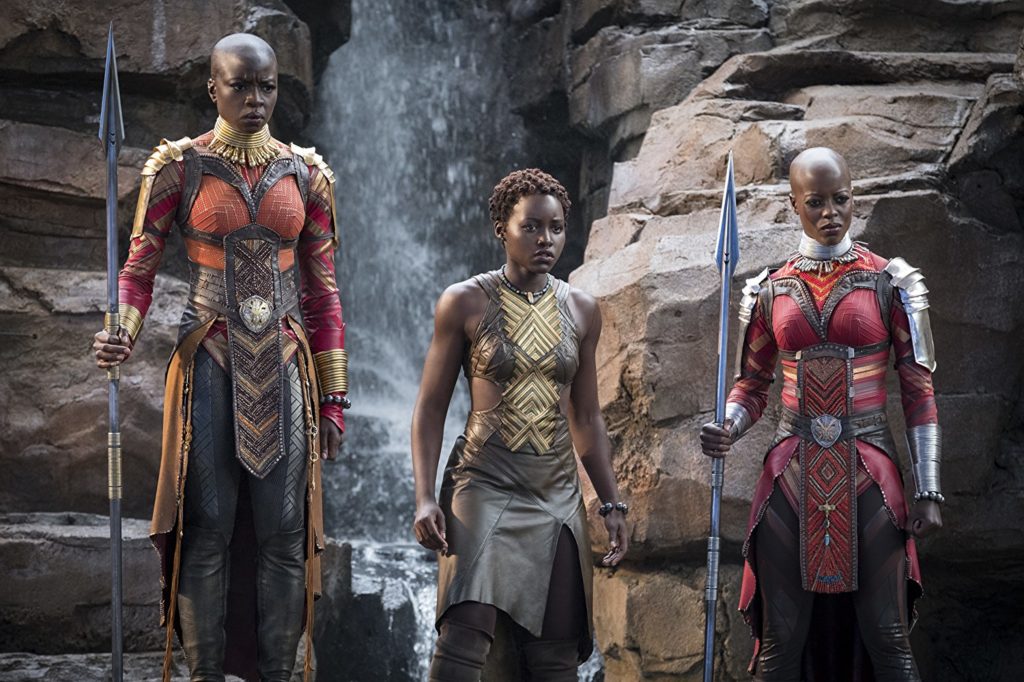
And then there’s cinematographer Rachel Morrison. The first female Oscar nominee for cinematography for her work in “Mudbound”, like Beachler, Morrison is best known for lensing smaller intimate works like “Cake”, “Little Accidents”, “Any Day Now”, and Coogler’s award-winning “Fruitvale Station.” With BLACK PANTHER, Morrison pushes herself into a larger landscape with a lighting and lensing design that retains the intimacy of visual storytelling for which she, and Coogler, are best known while creating a larger more expansive world. Not only are the visuals as a whole captured beautifully, but Morrison delivers some incredible lensing with lighting and camera angles. Angling, as well as overhead crane and/or drone shots, punctuated with very specific lighting, such as in the Korean casino or the Wakandan caves, further the tactile effects of Beachler’s production design. Morrison gives the lighting itself texture, specific to individual moments or locations, but nothing is more exquisite than the African sunsets and moments of dreamlike retrospect where visual effects meld with Morrison’s work. With such a CGI heavy film – much more than I thought it would be – kudos to Morrison and to the VFX team at melding the production light with the CGI light and reflection.
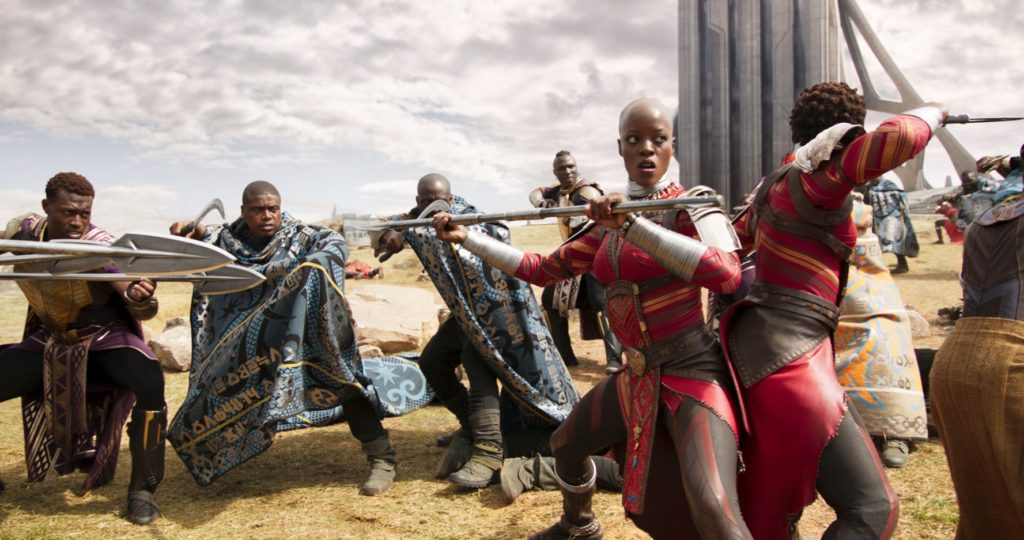
Not to be overlooked is the action of BLACK PANTHER and particularly that of an action-packed, car chase scene on the narrow streets of Busan, Korea. Taking heart-pounding excitement to a whole new level, Coogler’s method of real-time editing the scene while filming works like a charm taking the action sequence to a whole new level. Fight choreography is exemplary, both in mano-y-mano fights as well as a climactic land and air battle in Wakanda. (A side-note: make sure to check out the VFX armored rhinos as new fighting weapons.)
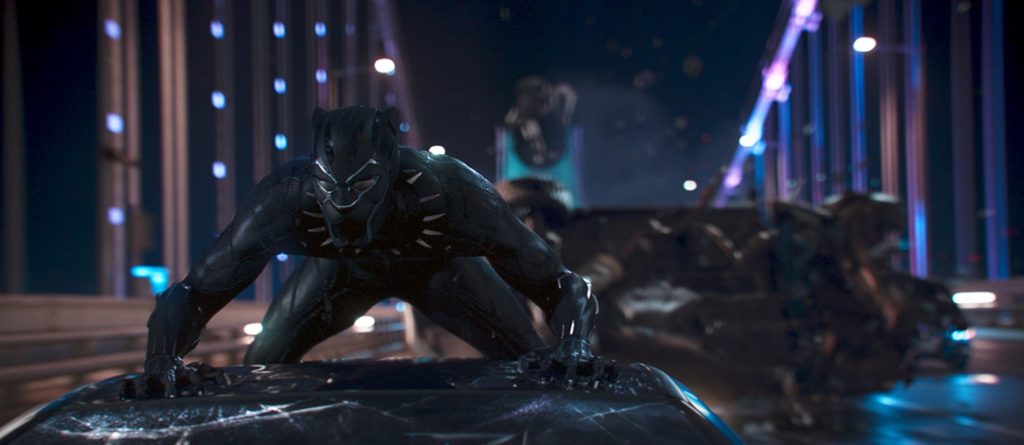
When it comes to performances, Letitia Wright is a delightful scene stealer and is not only one of the most engaging elements of the film, but the most realistic and relatable of the characters as T’Challa’s sister Shuri, as Shuri celebrates not only the push forward for women in STEM in the world today, but has rapier wit and perfect comedic timing laced with a devilish twinkle. She and Chadwick Boseman’s T’Challa are beyond believable with their brother-sister dynamic.
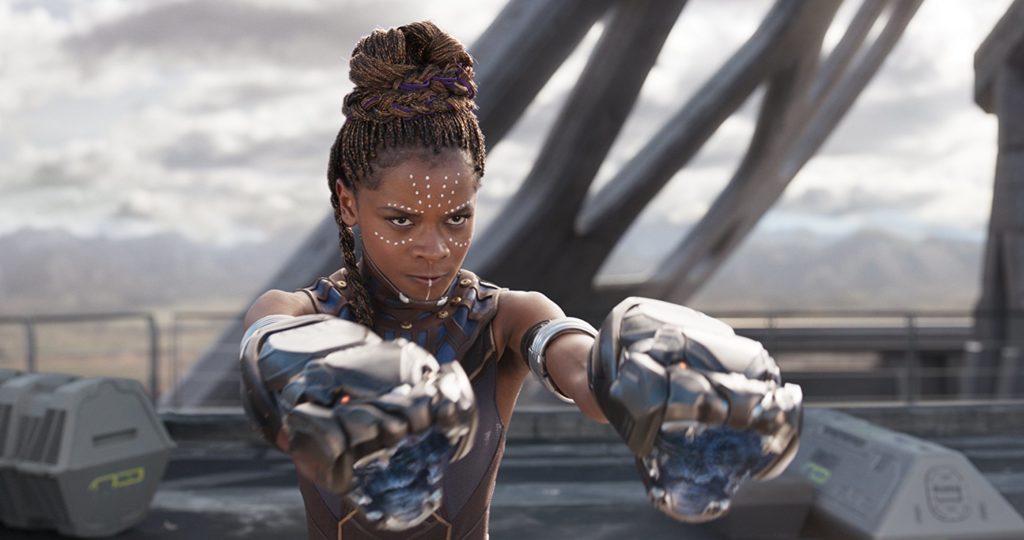
Joining Wright in the realism and relatability department is Angela Bassett. While more than believable as Ramonda, Wakandan royalty and mother to the new king, disappointing is her minimal screen time and the fact that Ramonda falls by the wayside by film’s end with no real resolution or “tie up”. Also disappointing is that Ramonda is never given an opportunity to impart any real words of wisdom to her son, but rather spends the bulk of the film beaming with pride and/or worrying. Script focus is on T’Challa’s obsession with his father and what his father would think and do, and in contrast to the bulk of the film celebrating women, makes Ramonda more of a background showpiece.

Speaking to the strength of the women of Wakanda, look no further than Lupita Nyong’o as Nakia and Danai Gurira as military leader Okoye. While Nyong’o gives Nakia a welcoming strength, spunk and sarcasm, Gurira knocks it out of the park with physical presence and emotional complexity, all of which Gurira conveys brilliantly through facial expressiveness and movement. Her eyes speak volumes. She is a physical storyteller and is beyond captivating in this role.
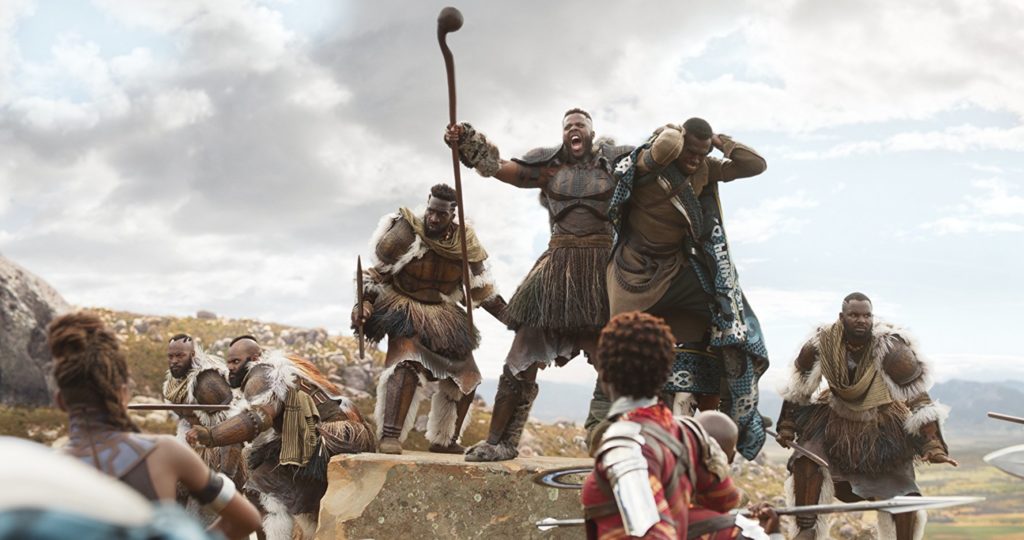
Winston Duke brings great humorous texture to the proceedings with his performance as M’Baku, leader of the mountain tribe. And keenly, camera is dutched upward throughout most scenes with Duke, tacitly adding the weight of leadership, power and defiance to him, making him an almost “fearful” adversary of T’Challa. As T’Challa’s right-hand and best friend W’Kabi, Daniel Kaluuya serves as a strong representation of the masses who can be easily influenced and swayed. Kaluuya demonstrates his acting chops (and why he earned an Oscar nomination for “Get Out”) bringing visual ambiguity and depth to W’Kabi as he deals with his frustration with T’Challa’s way of thinking versus the action-oriented fire of Killmonger, lacing the performance with tacit humility and shame at key moments. Kaluuya’s performance is a fascinating to watch arc.
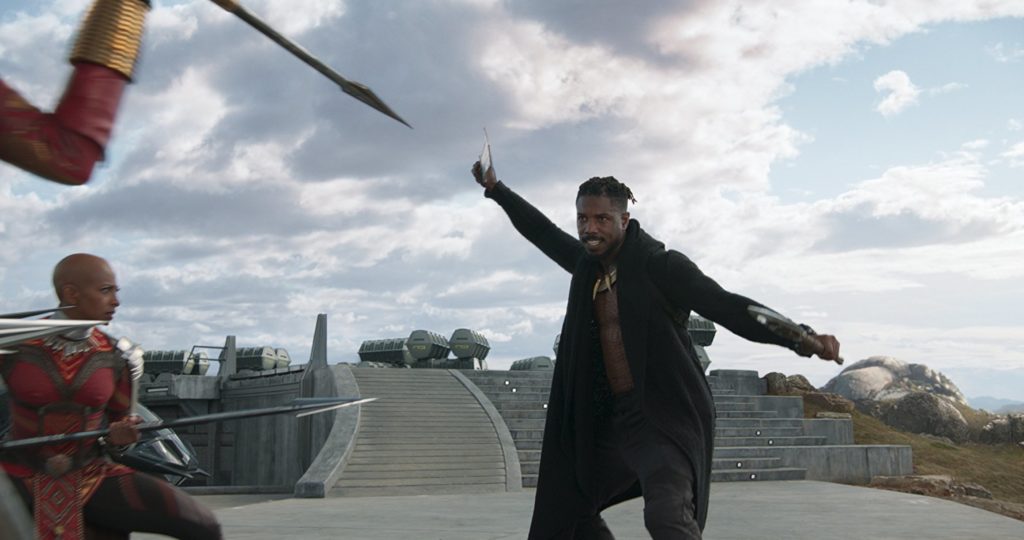
Gotta love Martin Freeman as Agent Ross, a little nebbish who becomes a hero! The character of Ross is one of the great things about the MCU in that a small, seemingly unimportant or background character often gets a chance to shine and have an unexpected hero moment. (Think Clark Gregg and his initial appearances in “Iron Man”.) Freeman brings pure unabashed glee to the role and plays extremely well opposite Wright.
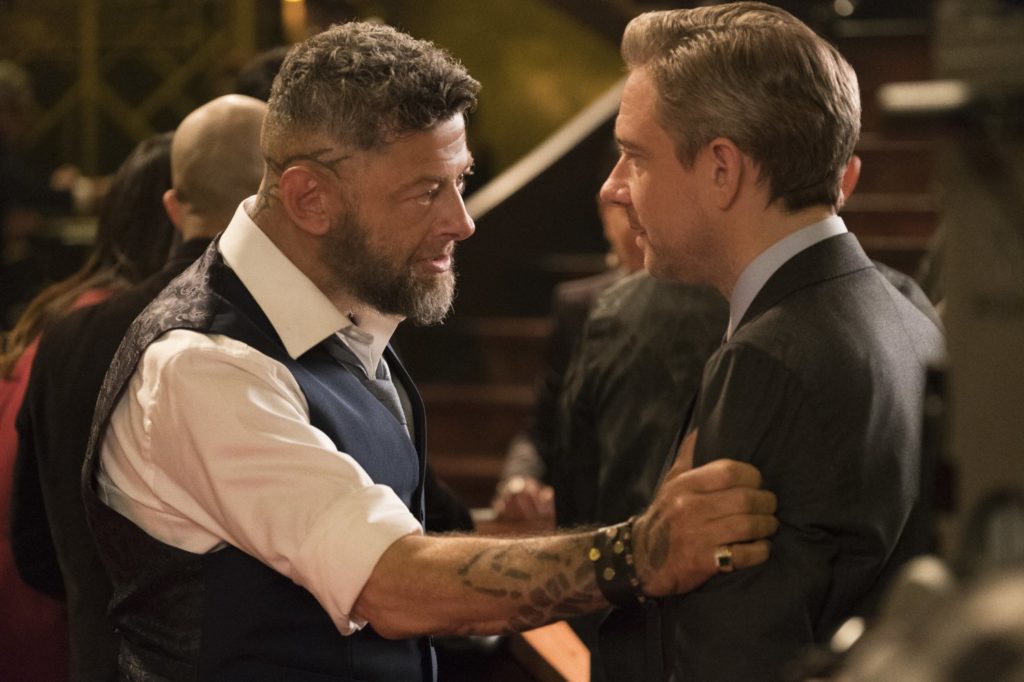
Sound design and editing is impeccable. Kudos to sound designer Steve Boeddeker and supervising sound editor Benjamin A. Burtt and their teams. Layered and multi-textured, sound design is an exemplary mix of weaponry slicing air, omnipresent drums which metaphorically appear as the heartbeat of T’Challa and Wakanda, score, dialogue and battle. Nothing is sacrificed at the expense of another sonic element. A beautifully executed aural experience.
Notwithstanding what are perceived issues with the radical militant dialogue and persona of Killmonger, BLACK PANTHER is slick, sleek and surprising. Ryan Coogler has proven himself more than capable of meeting and even exceeding the Marvel bar while retaining the intimacy of storytelling which is his hallmark. This is an entertainment experience not to be missed! And stay through the end of the credits for some treats and sneaks!
Directed by Ryan Coogler
Written by Ryan Coogler and John Robert Cole
Cast: Chadwick Boseman, Michael B. Jordan, Lupita Nyong’o, Danai Gurira, Forrest Whitaker, Letitia Wright, Angela Bassett, Winston Duke, Daniel Kaluuya, Andy Serkis, Martin Freeman
by debbie elias, review 01/31/2018











